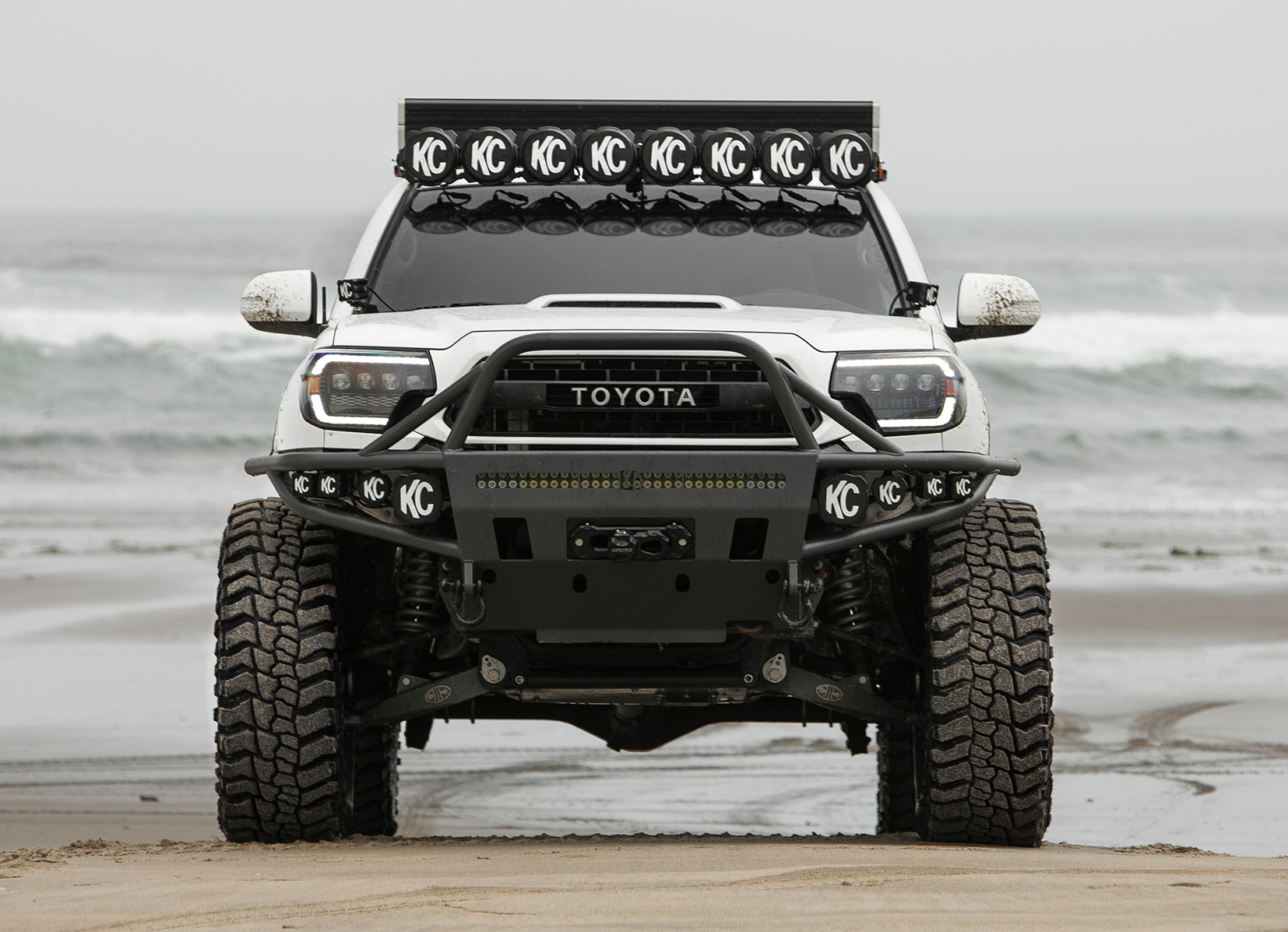
When it comes to long travel (LT) suspension on the Toyota Tacoma, you have many options to choose from. You don’t have as many compared to mid-travel lift kits and leveling kits, however, there is an LT kit out there for everyone’s needs.
Before we get into the specifics of a long-travel suspension and the offerings on the market, it’s important to understand what long travel is and why you might want to add this type of suspension to your Toyota Tacoma. Long travel isn’t for everyone as it’s rather expensive depending on the parts you’re running and designed for a very specific style of off-roading.
Long travel kits are designed for go-fast and rock crawler builds looking for more articulation (wheel travel) from their suspension. We will touch on the differences later but first, let’s learn the terminology.
Table Of Contents
Terms
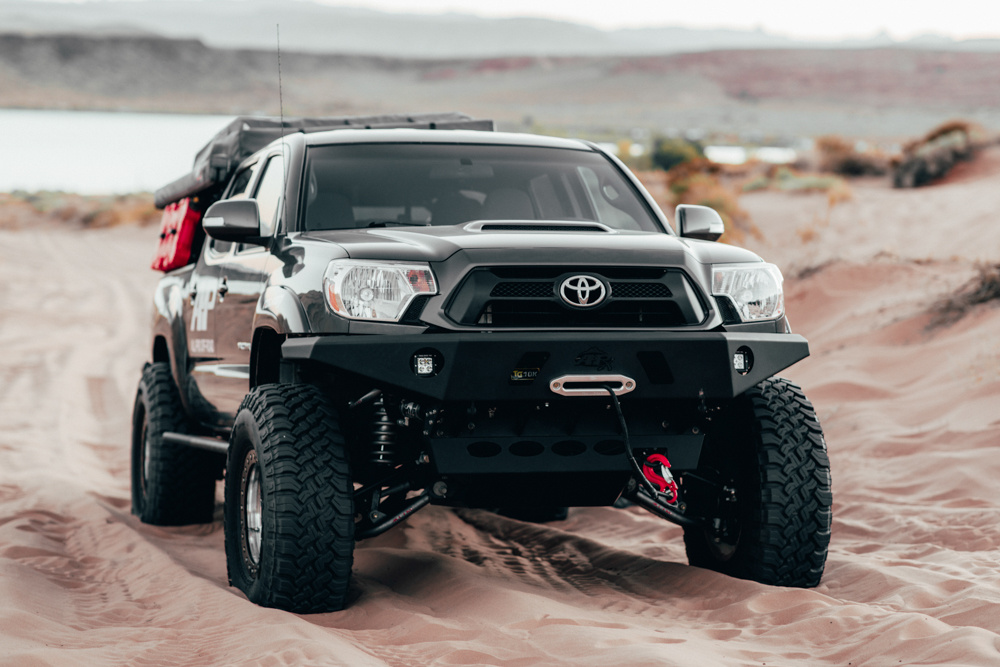
- LCAs and UCAs: The foundation of what’s considered “long travel” starts with your A-arms; LCAs (lower control arms) and UCAs (upper control arms). Your lower and upper control arms push the wheels farther away from the vehicle’s center frame and are measured in inches; 1″, 2″, 3″, and beyond. Aftermarket A-arms can be boxed or tubular, are made of Chromoly, aluminum, and/or steel depending on the brand. Lower control arms often add internal gussets for increased strength and tube style upper control arms add external gussets for added strength. Long travel a-arms are typically configured with heim joint or bushing pivots at the frame/shock bucket and uniball joints or ball joints at the spindle knuckle pivot however some companies offer uniball joints for both.
- Coilovers: The primary shock used for LT starts around an 8″ stroke and at least a 2″ body, however, most are 2.5″ body shocks. If you’re not running secondary bypass shocks, you want coilovers that offer remote reservoirs and compression/rebound adjusters.
- Secondary Bypass Shocks: Bypass shocks are designed to handle compression and rebound damping. With secondary bypass shocks, you don’t need compression and rebound adjusters on your primary coilover, but you can run them. Secondary shocks usually range from 2.0″ to 3.0″ wide.
- Shock Hoops: Tubular hoops with shock mount tabs welded to the frame are designed to hold the secondary bypass shock to the lower control arm.
- Shock Stroke: The measurement of how far the shock shaft enters the shock body between full extension (droop) and full compression (bump). Long travel shocks usually range in lengths of 12″ – 18″ for the rear and 8″ – 10″ for the front.
- Remote Reservoirs: Remote reservoirs help to dissipate oil heat in the shock body when the suspension is cycling. Remote reservoirs can contain a larger volume of oil which helps prevent the shock from overheating and allowing for more consistent damping.
- Bump Travel: When the shock compresses in an upward motion. Also known as up-travel.
- Droop Travel: When the shock rebounds in a downward motion. Also known as down-travel.
- CV Axles: Extended and typically stronger CV (Constant Velocity) axles push the knuckles farther from the center frame and oftentimes offer more articulation than factory CV axles.
- Brake Lines: Extended soft brake lines help to prevent snapping brake lines when the suspension cycles at full droop.
- Tie Rods: Extended and stronger steering rods connect your steering rack to your knuckles.
- Rod-Ends: High articulation heim joints that connect steering knuckles to the tie rod and the tie rod to the steering rack.
- Steering Clevis Kits: The steering rack clevis/bolt assembly threads into the steering rack which connects to a heim join that’s connected to the inner tie rod.
- Bump Stops: Either extended height rubber bump stops or welded-on brackets for hydraulic bump stops (usually hydraulic).
- Bump Stop Cans: Metal cans welded to the frame that hold hydraulic bump stops in place.
- Fiberglass Fenders: Extended height and width fenders allow tires more up travel clearance.
- Limit straps: Straps that prevent the suspension from overextension at full droop.
- Bed Cage: Bolt-on or welded cage in the bed of a truck designed to be mount points for rear 14″ – 16″ shocks. Bed cages hold spare tires, jacks, and other Prerunner accessories among other benefits.
- Spring Under Axle (SUA): Leaf springs are set on perches underneath the axle. Usually provides more bump travel over SOA.
- Spring Over Axle (SOA): Leaf springs are set on perches on top of the axle. Usually provides more ground clearance over SUA.
Define “Travel”

Define Travel
Travel is determined by the amount (in inches) of the distance between full droop (down-travel) to full bump compression (up-travel). Usable wheel travel is when all your suspension components work together creating a full range of motion. You can measure wheel travel by removing your shocks and cycling the suspension from full droop to full bump. Factory travel differs on many makes and models, however, 8″ is average for the Tacoma. Companies that offer long travel for the Tacoma quote anywhere from 10-14″ of usable wheel travel.
Shock Travel Vs. Shock Stroke?
Oftentimes travel is confused with the shock stroke measurement. Shock stroke is a measurement of how far the shock shaft enters the shock body between full extension and full compression.
Factory Travel Vs. Mid Travel
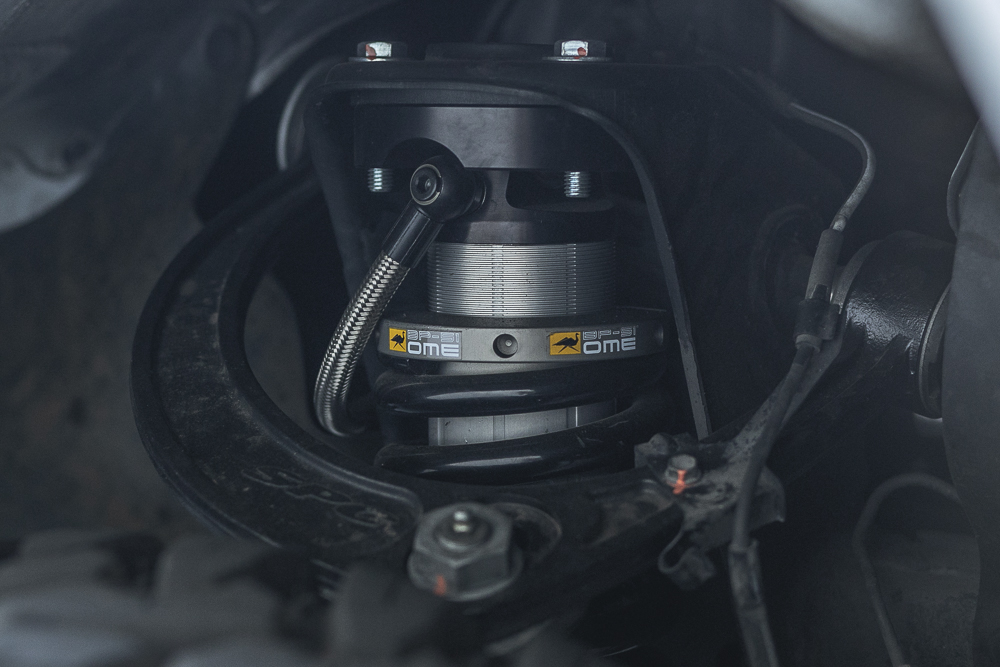
Pictured: ARB BP-51 Mid Travel Coilovers
Factory or “stock” travel is the amount of wheel travel you have from the factory, usually around 8″ for the Toyota Tacoma.
What Is Mid-Travel?
Mid-travel is a term used to describe a suspension that increases factory travel with extended-height coilovers that feature taller and wider shock bodies that are threaded/ adjustable for ride height. These kits are often paired with aftermarket UCAs (upper control arms) with built-in positive caster to reflect/correct the alignment change after lifting the Tacoma.
Sometimes mid-travel suspension kits are often mistaken with other coilover set-ups as the terms are intertwined. For example, just because a coilover is adjustable doesn’t mean it’s mid-travel. The Bilstein 5100 is a perfect example – it’s adjustable but definitely not considered mid-travel. The Bilstein 5100 kit and similar lift/leveling kits/shocks are simply referred to as such; lifts and leveling kits. I would refer to this style of lift as an “entry-level” lift kit and sometimes these upgrades don’t lift your Tacoma at all, guys just upgrade shocks for factory ride height.
Where entry-level lift kits are physically lifting your truck and mildly increasing performance (0″-1″ added wheel travel), mid-travel suspensions are not only lifting but providing much more control and drastically increasing performance (1″-2″+ in added wheel travel). You can compare these to long travel lift kits that usually result in 3″-5″+ in added wheel travel.
Good examples of entry-level suspension kits would be the OME Nitrochargers, Eibach Pro-Truck Lift kit, and again the Bilstein 5100 kit linked above. Good examples of mid-travel setups would be the OME BP-51s and kits like the Fox DSCs, Kings, Icon extended travel stage 2 kit, Bilstein 8112s, and many others.
With mid-travel, you’re changing the factory suspension greatly but there’s still room for more travel.
If you want to push your Tacoma faster and harder than mid-travel allows, a long-travel suspension is likely the next step.
What is Long-Travel?
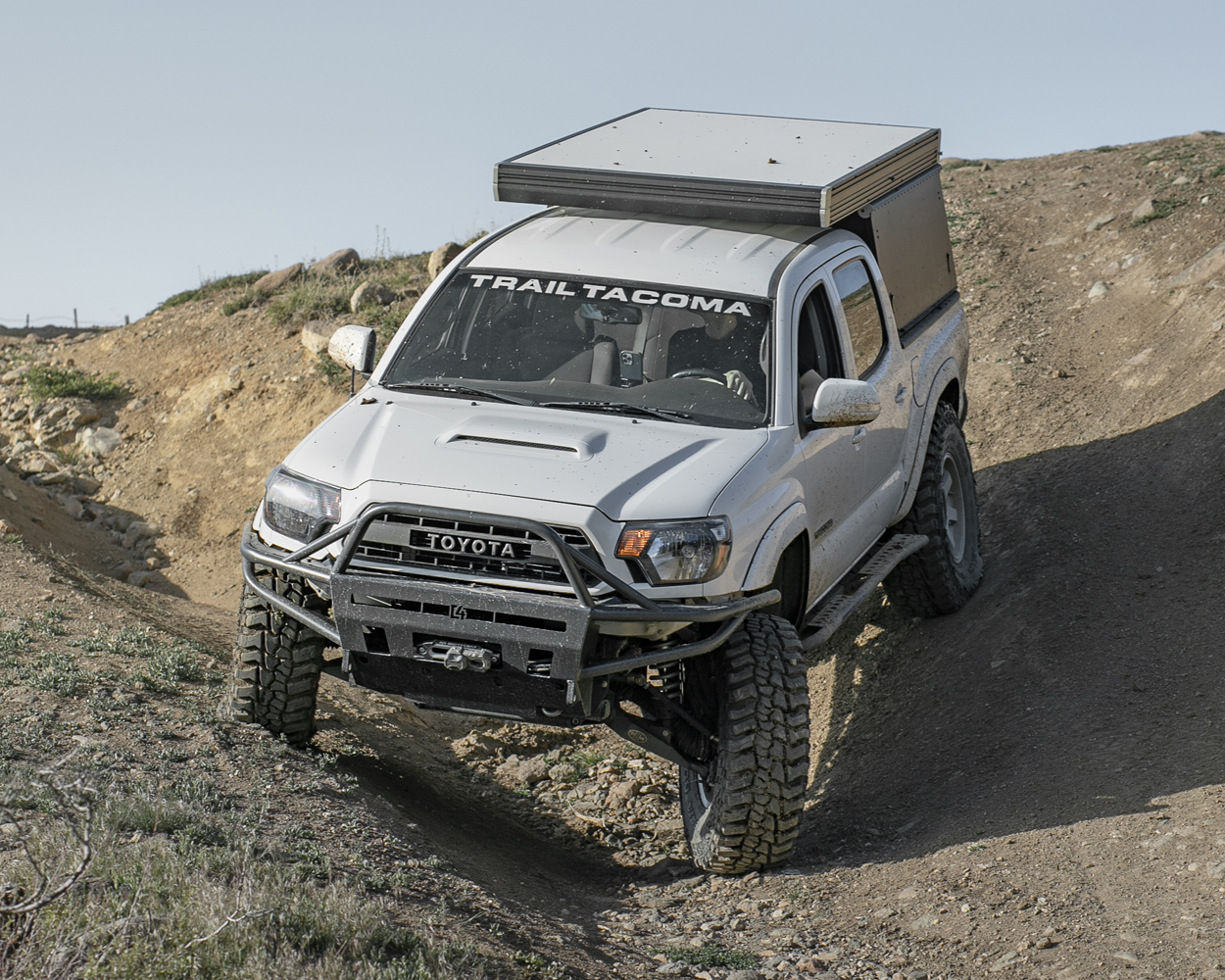
What Is Long Travel?
Long travel suspension is when you increase the length and/or height, and often the strength of your factory suspension components beyond the limits of your factory suspension geometry. Compared to mid-travel, long-travel suspensions provide even more wheel travel.
Where mid-travel kits feature extended-length coilovers and aftermarket UCAs to correct caster, long travel kits contain many more parts. In a typical LT kit, you see extended-length UCAs, extended-length LCAs, larger coilovers (typically an 8″ stroke to start), secondary bypass shocks, extended-length CV axles, extended brake lines, extended tie rods with strengthened rod ends, extended (both height and width) fenders, extended bump stops to prevent bottom out, limit straps to prevent top out, and more.
See how many times I listed “extended”? With long travel, everything is longer/wider, and stronger.
With LT, shocks usually range in shock strokes from 8″-12″ for the front and 12″-18″ for the rear.
How Much Travel Do You Need?
Where 4″ of up travel and 4″ of down travel is the standard of most Tacomas. 6″ of up and down travel is a good starting point to look at when it comes to LT. For go-fast rigs, the priority should be on up travel whereas rock crawler rigs focus on both but less on up travel.
Go fast rigs want about 60%-70% more up travel whereas rock crawler rigs want about 30%-40% up travel, however, this is not always the case and you should engage the company you’re considering to determine what’s best for your build.
Example – Go fast Tacoma with 12″ of total travel in the front:
A go-fast long-travel Tacoma should aim for 7″ up travel and 5″ down travel.
For the rear, up travel should be 25% more than the front. Take 25% of the 7″ front up travel and add that to the rear up travel.
If 25% of 7″ = 1.75″ we want our rear up travel to be at least 8.75″.
Travel Distance (Wider per side)
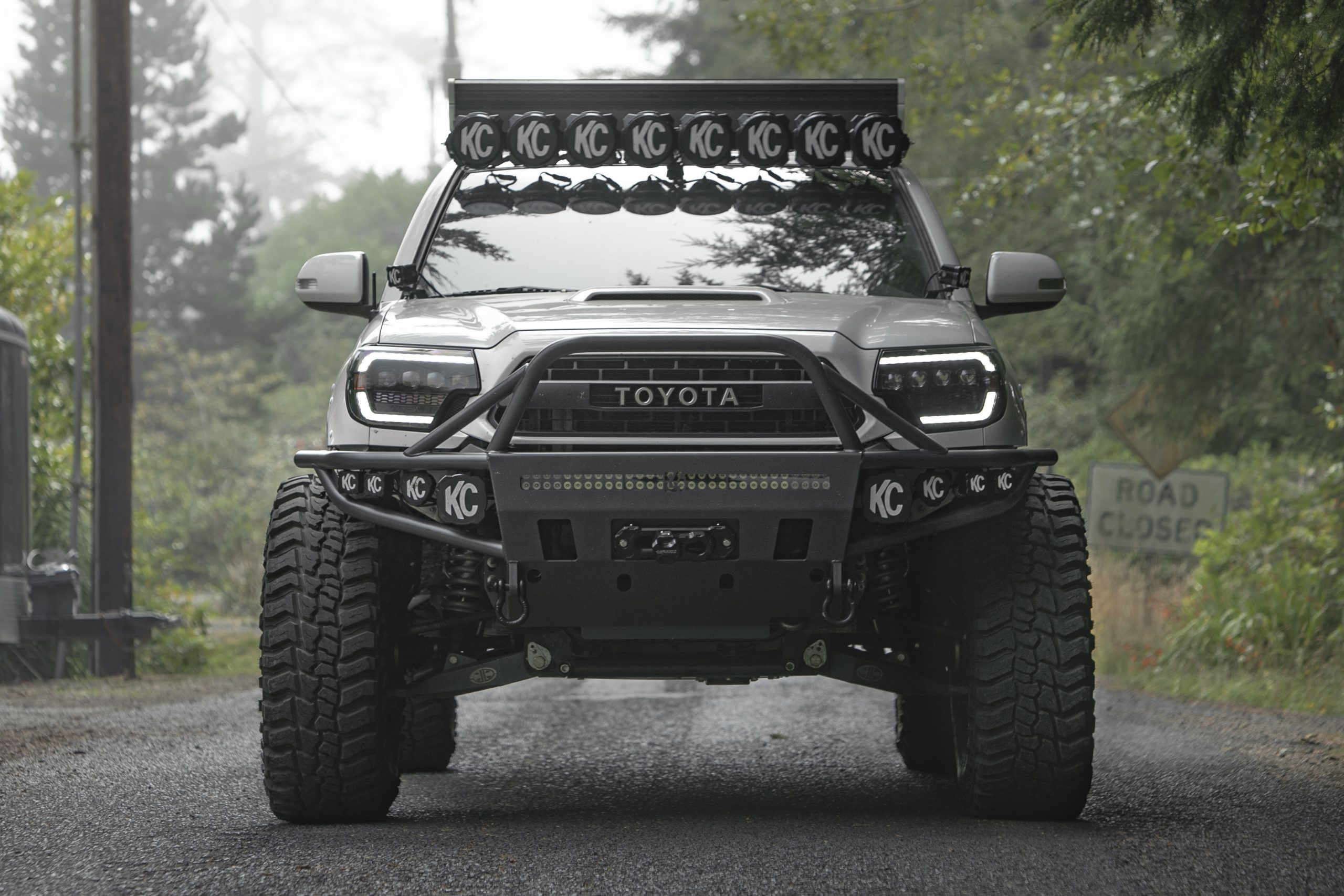
+2″ Vs. +3″ Vs. +4″ – which distance should you choose?
Long travel is measured by “per side”. When you see a +2″ kit, that’s 2″ wider per side creating a track width of +4″ overall.
2″ Class
2″ kits are usually the “stage 1” of LT, also referred to as “Prerunner” kits, ranging from +2″ and up then typically scaled in 1/4″ measurements; +2.25″ and/or +2.5″, etc. The +2″ class kits yield anywhere from 11″-13″ of usable wheel travel. In this class, companies make many great options. For example, Total Chaos offers a standard 2″ kit and an expedition 2″ kit. The expedition kit offers 2 more inches of ground clearance over the standard 2″ kit. So even though a kit is marked as a 2″ long kit doesn’t mean they all boast the same specs. Also in this class, Camburg makes a 2″ Trail Series kit that’s designed around tight trail use and to perform well for daily driving all without needing to upgrade fenders. There are many other 2″ kits on the market but one that stands out is the JD Fabrication 2.25″ kit that pushes upwards of 13″ of wheel travel and also features a slew of additional upgrades. With 2″ LT you don’t always need fiberglass fenders but a mild 1″ flare is recommended. If you avoid fiberglass, you will need to trim your factory fenders to see clearance at full compression (bump travel). This class is designed for daily drivers and weekend warriors, especially with something like the 2″ Trail Series from Camburg.
3″ Class
Next, you have 3.5″ kits and these are typically considered race kits commonly featuring uniball joints over ball joints. In the 3″ class, Total Chaos offers two versions of their 3″ class; the standard series and the race series. The race kit offers 2.5″ more ground clearance and is 5 pounds lighter per lower arm than the standard series. TC offers both poly bushing uppers and/or heim joint uppers. Both kits pull about 12.5″ of wheel travel. Also in the 3″ class, you have Dirt King. Dirt King offers their signature kit with bushing uppers and/or heim uppers yielding around 13.5″ of wheel travel. DK also offers kit-specific 4340 Chromoly axle shafts and/or prebuilt axles with factory Tacoma joints. Finally, you have Camburgs 3.5″ Race Series kit which is similar to the TC and DK kits, although it does stand out quite a bit in their overall offering which we’ll get into below. There are so many great options in the 3″ race class. With 3″ LT you will need fiberglass fenders; at least a 3″ flare and 2″ rise. This class is meant for hard-core weekend warriors who go out often and want to push the limits in the desert and/or in the rocks.
4″ Class
Last but not least, you have the 4″ class. This is a bit overkill for most but is very impressive nonetheless. With kits such as the LSK 4.5″ and the JD Fabrication 4″, you can get into the most advanced and race-focused rock and/or crawling-focused IFS long travel kits on the market. Most advanced doesn’t always mean best though. With 4″ class LT, you need large flare + rise fiberglass fenders, and all the suspension components are very custom; axle shafts, steering rods, brake lines, limit straps, shocks, bump stops, and even fabricated spindles that allow even more up/down travel. In this class, most kits come with everything you need because everything is such a custom length. Extending your track width out 4″ per side or even 4.5″ per side is a lot. This class is designed for someone who is looking to hit the ultimate send button on dunes.
UCAs & LCAs
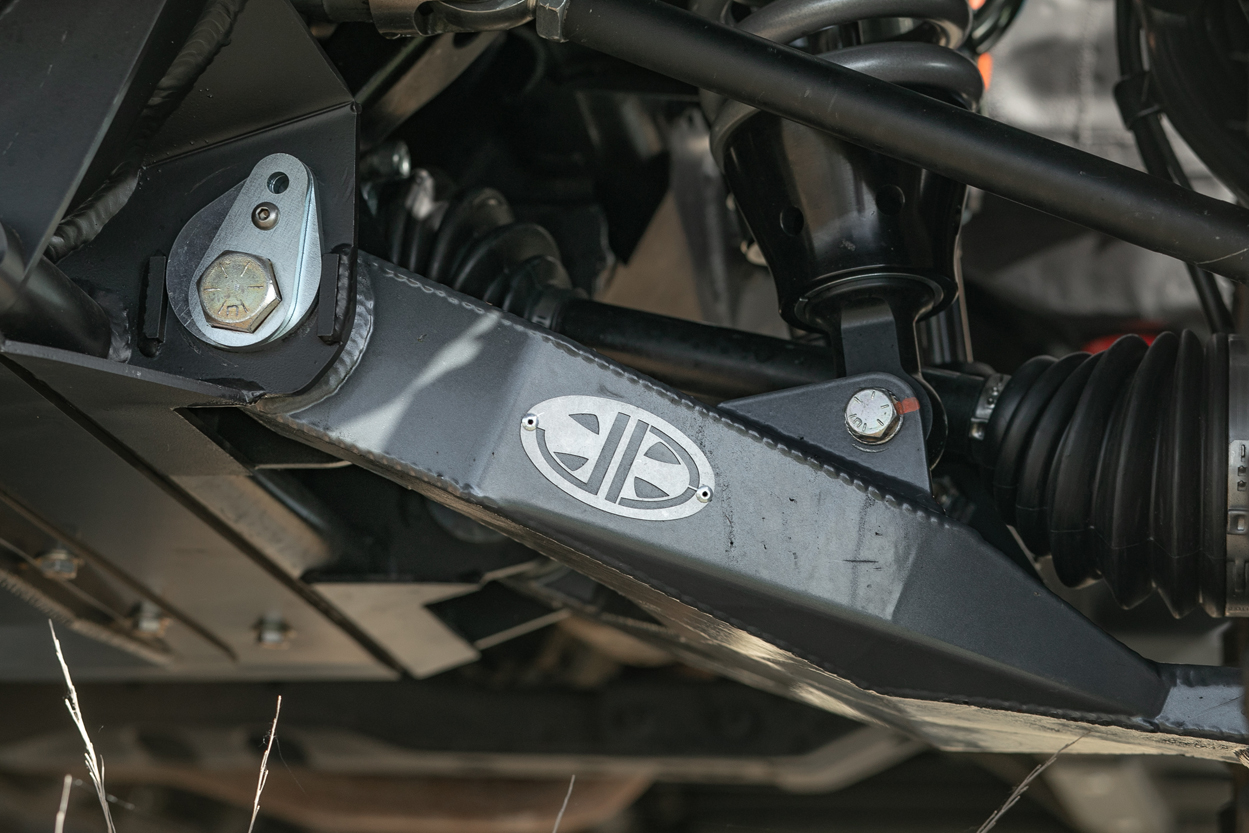
Not all uppers and lowers are created equal and long travel all starts with UCAs and LCAs. Here are a few key elements to look at when shopping for lower and upper control arms.
LCA Ground Clearance
An important item to consider when shopping for lower arms is clearance. Camburg uses a uniball adapter that goes under the uniball joint which positions the arm lower and actually offers less ground clearance than the factory. Dirt King and Total Chaos, for example, use the factory ball joint cradle so the lower arm goes above the joint which offers similar or even better ground clearance than the factory depending on tire size and other variables. For go-fast applications, ground clearance might not be as important for you. However, for rock crawling, ground clearance is very important. Pay attention to where the lower arm mounts to, on, or around the ball joint adapter.
LCA Front Slant
A slanted front surface for sliding over obstacles is very important for all drivers to consider, both go fast and rock crawling. Dirt King, Camburg, and JD Fabrication all offer a slant on the front of their LCAs. Pictured in the image above, you will see the JD Fab lowers with an aggressive slant on the face. Total Chaos, Marlin Crawler RCLT, and LSK on the other hand feature a completely boxed design with a flat front surface – not good for sliding over obstacles.
LCA Frame Pivots
Most companies such as Total Chaos uses polyurethane bushings at the frame pivot points. Dirt King, for example, uses Delrin bushings while JD Fabrication and Camburg both use 1″ uniballs. JD Fabrication takes it a step further and adds seals to their uniballs. Both the Derlin bushings and uniballs are going to offer a stiffer joint than poly bushings. Having stiffer joints is nice when you have 20%+ more leverage pulling/pushing on the frame pivots. With uniball joints, you have a wider range of alignment specs to increase your positive caster. Polyurethane bushings tend to squeak over time and don’t hold up well under extreme weather conditions.
LCA Wheel Placement
Some lower control arms have a positive caster spec and/or forward tire mounting built in. This is where you need to call each company you’re considering to ask whether or not they have a positive caster built into the arms and if not, how much room there is for adjusting the caster or pushing the wheel forward altogether. Dirt King, for example, has a positive caster spec built in, and so does JD Fabrication however JD goes a step further with its design. JD Fabrication builds cam tabs that allow forward positioning of the arm up to 7/8″ and that’s adjustable in increments of 1/4″. No one else offers that.
UCA Design
A major item to consider for UCAs is the uniball or ball joint and the cup. On vertically positioned uniballs, up travel is limited at the uniball cup colliding with the inner wheel well, and down travel is limited at the uniball colliding with the uniball cup. UCAs with an aggressive uniball cup slant will typically achieve more down travel. Pay attention to this slant on the UCA cup when purchasing UCAs.
UCAs from the LSK and Marlin Crawler LT kits, on the other hand, feature high-articulation horizontal uniballs. The down travel is now limited by limit straps and the up travel is limited by your tires depending on size. There is no doubt that high articulation horizontal uniballs on UCAs offer more up/down travel, however, this is highly dependent on tire size and other suspension components.
UCA Caster Correction
Because the Tacoma upper control arm is mounted from the factory in a different plane than the lower control arm, as you lift or lower the truck the caster changes. The more you lift the truck the more caster you lose. This is why it’s always recommended to add a “caster-corrected” upper arm when you lift a Tacoma. Most of the companies on this list all make caster-corrected UCAs, however, if you move forward with a kit, do your research first.
Uniballs Vs. Ball Joints
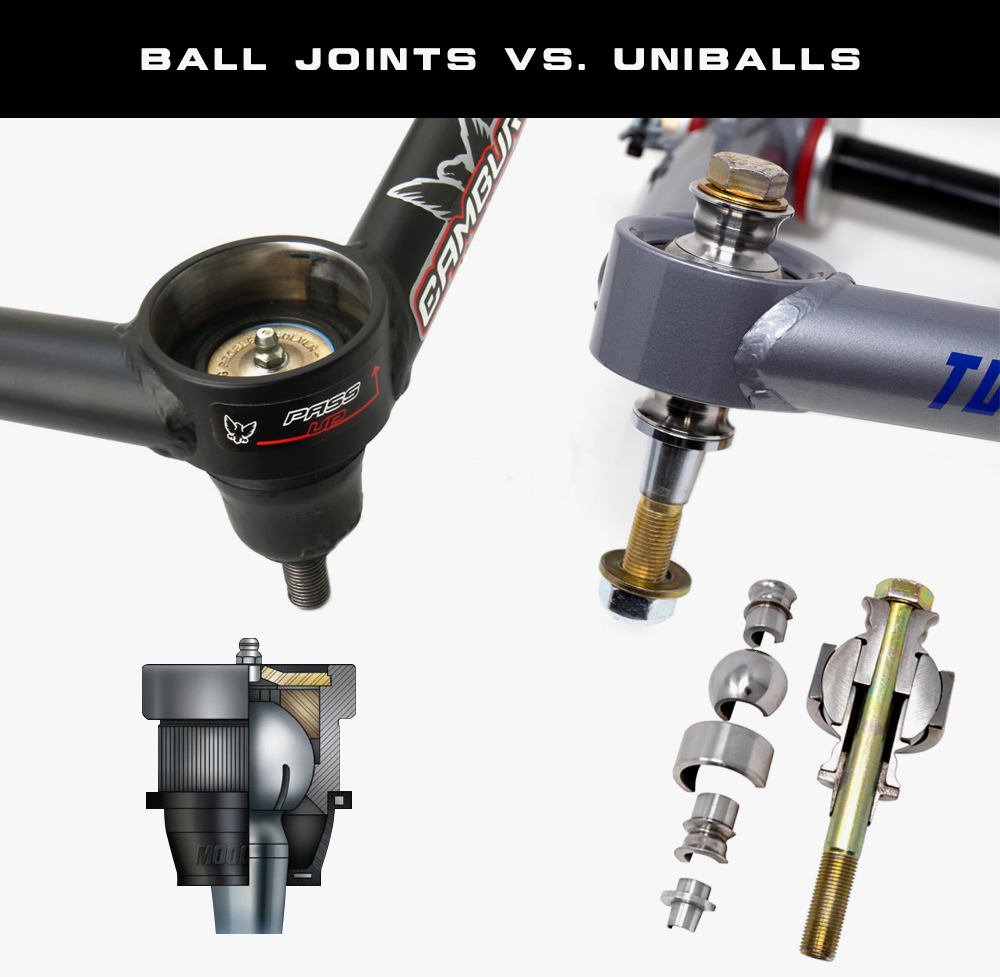
Camburg & Moog Ball Joints (left) and Total Chaos Uniballs (right)
The choice between uniballs and ball joints has long been a debate, although both have some noticeable differences over factory joints.
Uniballs
Uniballs are known to have more articulation than traditional ball joints which is nice when you’re looking for the most possible travel from an LT setup. On top of offering an impressive range of motion, the uniballs architecture is stronger than that of a ball joint. Uniballs do require maintenance though and if neglected – over time they can start to squeak, and/or become loose. Because uniballs are typically stronger and offer the most articulation, they are used on most builds for professional race classes like Ultra4.
Ball Joints
Ball joints on the other hand were designed for the daily drivers of today’s world. Unlike uniballs, ball joints are a sealed architecture and therefore require less maintenance. Some will say that ball joints have less articulation than their counterparts, however many companies like JBA offroad claim a full 90 degrees of motion, and other companies that feature an aggressive uniball cup slant can also achieve high articulation with ball joints.
Sealed Uniballs
JD Fab uses its own solution which is the best of both worlds. They have custom EMF joints made with the factory Tacoma taper machined into the pins. An EMF joint is identical to a uniball in design however it’s built in a way to be completely sealed from the elements. The design gives you all the strength and articulation of the uniball while offering the sealed, maintenance-free design of a standard ball joint. They are also easily rebuildable which is a huge cost savings compared to replacing uniballs.
Shocks
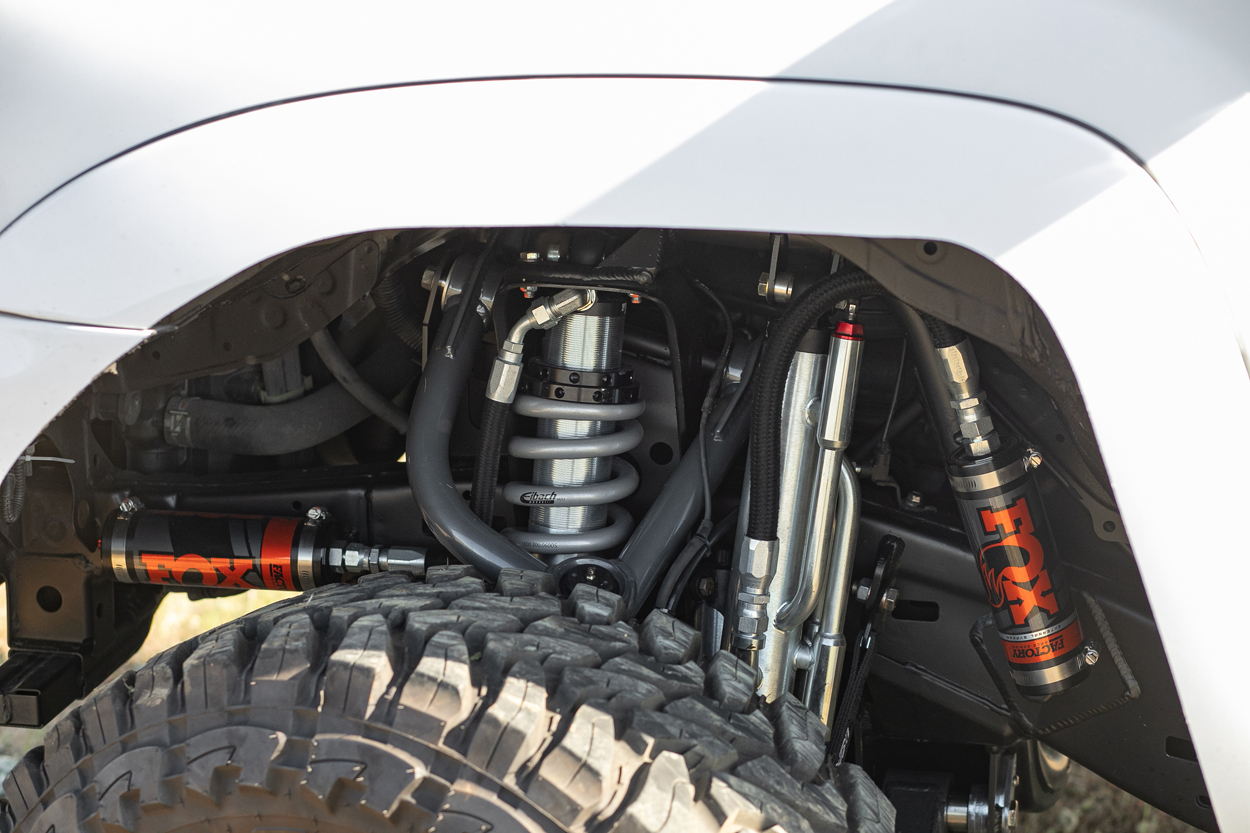
You have many options when it comes to shocks; King, Fox, Radflo, Icons, ADS, etc. They all make shocks for LT suspension setups although King and Fox tend to lead the race. Fox is actually the largest shock manufacturer in the world. They make shocks for many applications and Tacoma applications are no exception. King also dominates the Tacoma market and is known for producing some of the highest-quality race shocks on the market. Regardless of which you choose, you can’t go wrong with either brand. There is a reason why every major LT manufacturer pairs their kits with either King or Fox; they’re both very dependable race shocks, although Fox is slowly gaining more Tacoma traction. Compared to other shocks, Fox uses higher-quality seals, shock oil, and shafts. Fox is also more expensive than King, but again both are great choices.
There are many types of shocks that can be used for a long travel setup; coilovers, bypass shocks, piggybacks, and smoothie shocks.
Coilovers & Bypass Shocks (Front)
Companies that make an LT kit usually spec very specific shocks for that kit. For example, some companies lean on Fox and some on King. Some companies adjust the valving for those shocks in-house, and some outsource it or they’ll even pair the kit with Toyota OE shocks. That said, most will spec an 8″ stroke with reservoirs along with an 8″ stroke on the secondaries, also with reservoirs. For most LT suspension kits, an 8″ stroke is plenty of shock travel for the front of the Tacoma running a +3″ kit or under. If you can, order the shocks that the company recommends because they are often tuned specifically for that kit.
Reservoirs & Adjusters
Reservoirs along with compression/rebound adjusters are an added bonus on all shocks. If you plan on pushing your limits and going fast, then reservoirs will help to keep your shocks from overheating. Adjusters are going to offer adjustments for stiff or loose piston stroke which means you can adjust them to be stiff while on road and loose while offroad. Adjusters are great for someone who plans on using the truck as a daily and weekend wheeling.
Double Shear

Double shear is defined as twice the shear force breaking strength. So for example, let’s look at double shear steering on the knuckles. In a factory steering setup, the tie rods’ rod end is connected to the knuckle with one bolt on one mounting surface (single shear). With double shear, a single bolt is still used, however, you sandwich that bolt between two surfaces (double shear). Now instead of one surface resisting the load, you have two surfaces. The bolt in double shear will have twice the shear strength of a bolt in single shear.
When it comes to long travel, many components are upgraded to double shear; inner and outer rod ends for steering, UCAs on the coil bucket, secondary shocks, and more.
Steering Rack
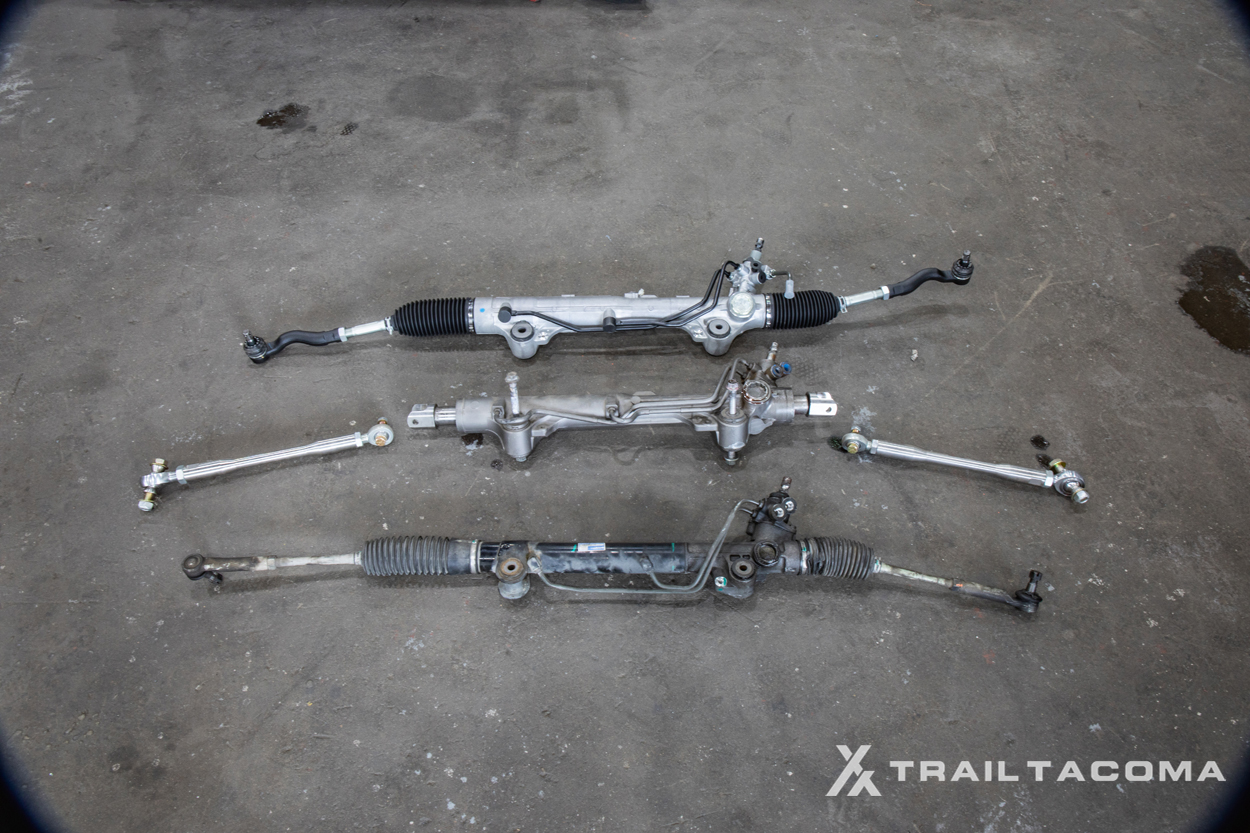
Factory Steering Rack (bottom), Tundra Steering Rack (Middle), Land Cruiser Steering Rack (top)
Most long-travel suspension kits on the market offer a solution for increased strength tie rods and rod ends but not a full steering rack replacement solution.
For most LT kits today, the rod ends being used are known as heim joints or “heims”. The outer rod ends thread onto the tie rod and connects to the knuckle. The inner rod ends thread onto the other end of the tie rod and connects to the steering rack. You can use factory inner rod ends or upgraded heim joints.
Depending on what steering rack you’re running will depend on how that inner rod connects up to a steering rack. If you’re running a factory Toyota steering rack and factory inner rods, just thread your tie rod onto the inner rod end.
If however, you upgrade to a Tundra or 200 series Land Cruiser rack, you will need a steering clevis kit with the correct thread pitch and bolt diameter. For the LC200 rack, you will want a 28mm clevis and for the Tundra, you want a 24mm clevis (RC Fabrication can sell you both of these). You can, however, use the factory inner rod end that comes on the LC200 rack as the rod end is a good length for the Tacoma and plenty strong enough to turn a 37″ tire. But for the Tundra rack, you need to shorten the inner rod and rack down as the width is too long for the Tacoma. That is why Solo Motorsports makes a modified steering rack specifically made for the Tacoma.
Not many guys want to run the factory steering rack, especially after upgrading all of the other steering components. It’s the path of least resistance to the steering rack after double shear steering, and increased strength rods + rod ends – all while running increased size tires.
With that said, very few long travel kits on the market offer a complete solution all the way down to the steering rack. The Marlin Crawler RCLT kit does come with the “MarRack steering rack” which is an LC200 rack but they provide the pieces that can be challenging to source that connect the steering rack to the column.
Steering Rack (Rack & Pinion) Options:
200 Series Land Cruiser Rack Options:
Lowest to the highest price
- Ultra Power 3676N
- A-Premium 369
- AAE AA36N Steering Rack (USA inspected & tested)
- Buy Auto Parts Remanufactured 80-01660R
- Toyota OE Rack & Pinion 80-01660R (this is the steering rack I bought)
Extended-Length CV Axles
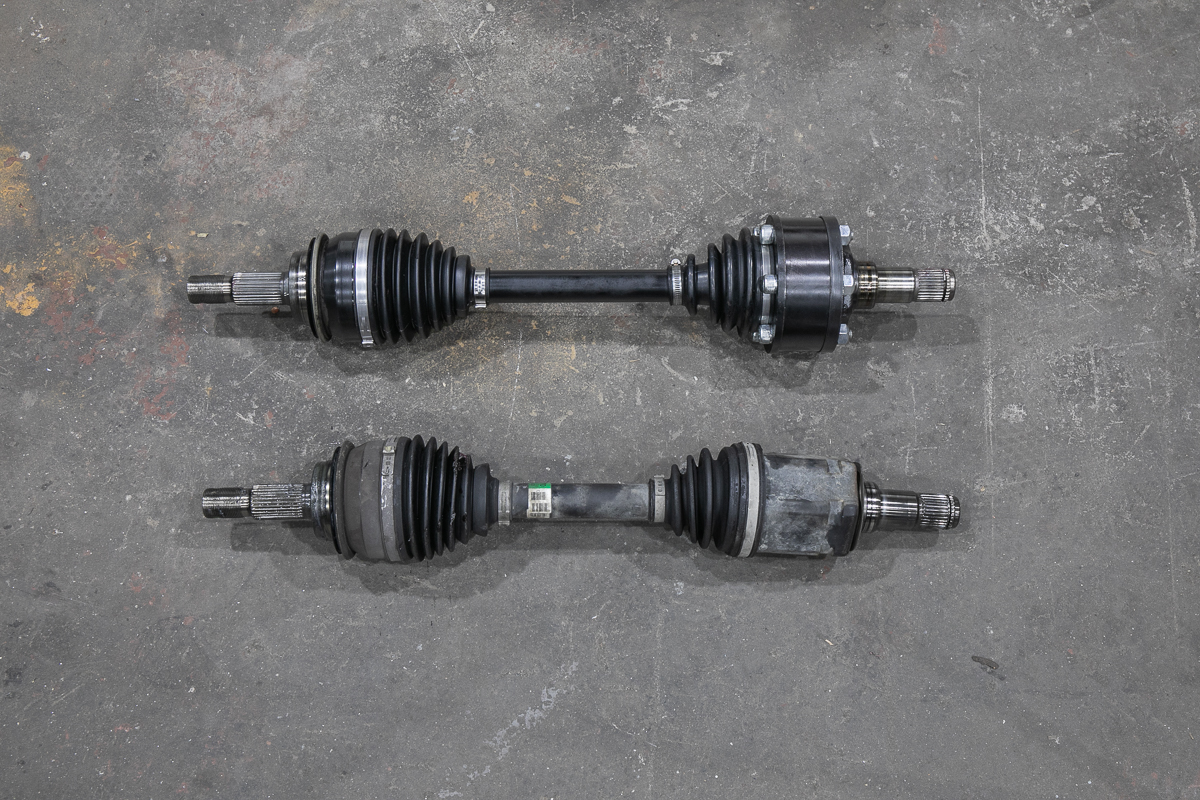
You have a handful of options when it comes to running extended-length CV (constant velocity) axles.
For the most affordable option, you can run upgraded extended-length shafts (usually Chromoly or 300M) and reuse your inner and outer CV joints. This is affordable but it’s also very time-intensive as well. In order to rebuild the inner and outer CV joints, you need the right tools and a bit of patience. It’s not hard at all, just time and energy.
The next option is to buy partially pre-assembled axles and rebuild the outer joints of a CV axle only. This is usually when you want something a bit more custom and you’re either looking for a very specific type of inner joint or you want to save a bit of money by rebuilding your outer CV joints.
The most common option is to go with a company like RCV Axles and/or CVJ axles. These companies offer fully built CV axles designed for your specific width and application. Both of these companies offer great axles but RCV is usually the go-to because they pre-package axles specifically for mainstream kits like Total Chaos, Dirt King, Marlin Crawler, and others. If you have a custom long travel kit, or it’s a new and upcoming company that makes suspension components only, you may need to ask them exactly what CV axle they recommend for that kit and from what company they have tested their kit with.
Different companies offer different joints, too. Most companies offer rebuilt axles with factory-style architecture inner tripod joints and outer ball-style joints, although some offer internal components (4340 and/or 300M) that are much stronger. Some joints are strengthened even more with an upgraded cage as opposed to factory-style housing. For example, companies like JD Fabrication offer a 934 plunging CV axle joint. The 934 offers a full 28 degrees of articulation versus the stock joint sitting 21 degrees. The factory-style joints with upgraded internals are a bit more affordable than the 934-style joints but the 934 is even stronger and provides more articulation. The 934 is a clear winner but it comes at a higher price.
Before going all-in on axles, call these companies, explain your driving habits (fast and hard or slow and abusive) and they will tell you which axle is the best fit for you.
JD Fabrication 934 Axles (stock width, 2-2.5” and 3.5-4”)
- Fully or Partially Assembled with Core Exchange (2005-2015)
- Fully or Partially Assembled with Core Exchange (2016-current)
CV Axle (assembled) Options:
CV Axle (assembled) Options:
Shaft-Only Options:
- Call RCV and Order Length; +2″, +2.75, +3.5″, etc: (815) 877-7473
- Call CVJ Axles and Order Length: 1-800-292-2953
Inner & Outer Boots
Spring Under Vs. Spring Over
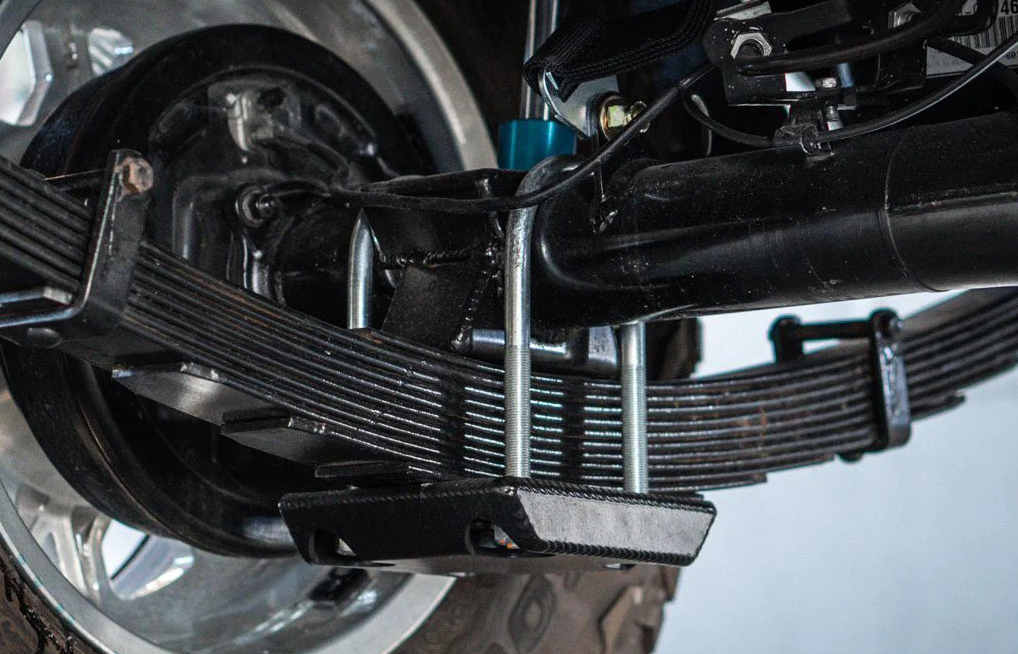
The debate between spring under axle (SUA) and spring over axle (SOA), has long been a controversial topic. Both options have their own unique pros and cons. Before you decide which option you’re going to proceed with on your build, first decide how you’re going to use your build. Are you moving fast through the desert over large whoops where lots of up-travel is needed or crawling slowly over large rocks where good, high clearance and good departure angles are needed?
It’s pretty simple at the end of the day; SUA is typically for fast guys and SOA is for guys who want more clearance – but not always. Again, this topic is one that’s debated hard on many different makes and models.
I’ve listed some bullet points below on a general consensus, however other factors can affect some of these bullets ultimately swaying them to the other side or making them a moot point. For example, some guys will claim SUA boasts better ride quality but ride quality is heavily dependent on spring weight and loaded (wet) bed weight. Can SUA provide a “better” ride quality? Yes, given you have all the other factors dialed in for that specific set-up. Other factors to fine-tune for overall ride quality and performance may include the height/drop of the front/rear shackle hangers, Deaver H70 Vs. H70HD springs, location of shocks, shock stroke, shock valving/tuning, location of perch over/under the axle, hydraulic bumps vs. progressive rubber bumps – along with other factors.
Can you achieve more travel with an SUA kit? Yes.
Does every build running LT in the front need an SUA rear? No.
Spring Over Axle (SOA):
- Better for rock crawling and higher clearance applications
- Provides more ground clearance than SUA
Spring Under Axle (SUA):
- Better suited for desert racing, fast, whoop-focused applications
- Usually provides more travel; specifically more up-travel or “Bump Travel” than SOA
- Lowers ride height
- Minimizes axle wrap
Spring Under Kits:
- Total Chaos Pre/4wd mid-travel (9.5″ travel)
- DMZ Pre/4wd (13″ travel)
- Dirt King Pre/4wd (16-18″ travel)
- JD Fabrication Pre/4wd (17-19″ travel)
- Camburg Pre/4wd (19″ travel)
Questions to Ask Before Buying
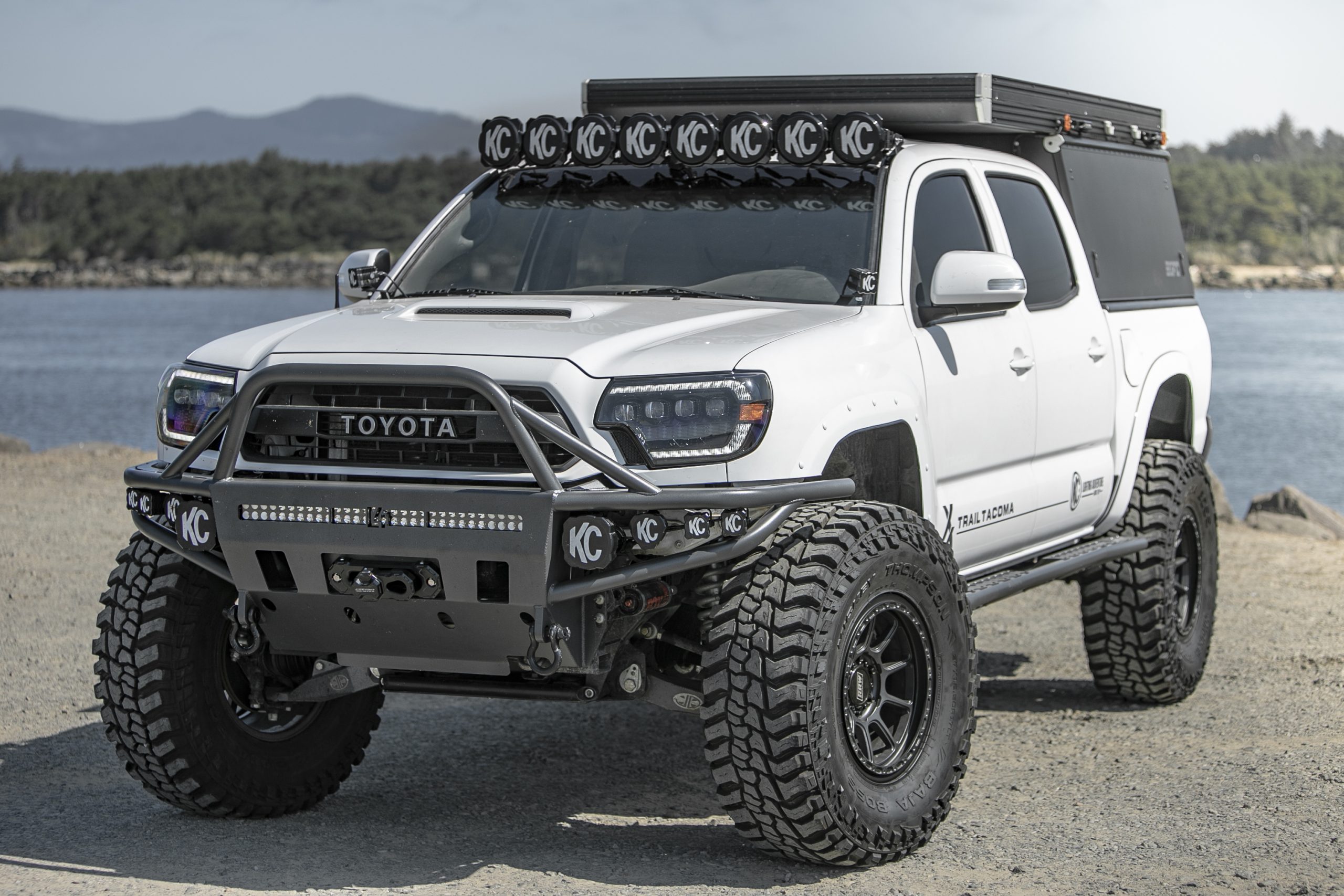
Before you run out and throw your hard-earned cash down on the first long travel kit that catches your eye we have put together a list of questions that everyone should be asking. As with most things in life people tend to gravitate towards the “bigger is always better” motto. Long travel is no different and the assumption tends to lean towards the company with the biggest travel numbers being the best. This couldn’t be further from the truth and the reality is the best product is the sum total of all of its parts/features. With that said here is the list of the top three questions you should be using when evaluating the different long travel kits.
1. How long has the company been in business?
There are a lot of fly-by-night off-road shops throughout the country and only a handful of companies have been around for 20+ years. Having the piece of mind that you are purchasing a kit from a company with a solid track record is invaluable. After all, if things fail or replacement parts are needed you want to know the company will be there to assist you.
2. How long have they manufactured long-travel IFS kits?
If the company has been in business for 20+ years but just started making long travel, you should consider that. Building an off-road IFS kit that can withstand whatever abuse you can throw at it is no small feat and refining the most optimum design can take years. The knowledge and experience a company holds are best gained from years and years of experience building long-travel IFS suspension components.
Most important of all is knowing that the company you purchased your kit from stands behind its product and is willing to assist you whenever you have questions. The older more established companies that have been producing long-travel IFS kits for decades are still in business for a reason and that’s not to be taken lightly.
3. What materials are used for the construction?
All too often this one gets glossed over but it’s important to know what materials these kits are made out of. Is the company using low-cost, low-strength mild steel or super strong, high-grade 4130 Chromoly? The strength difference between the two is dramatic and knowing what’s under that fancy powder coating is not to be overlooked!
4. What materials are used for the suspension pivots?
Is the company using poly bushings that become noisy and wear prematurely? Are they using harder Delrin bushings instead of poly? Did they do away with bushings altogether in favor of uniballs? How about sealed uniballs?
While the cost of uniball pivot arms has a greater upfront cost the performance and reduction of maintenance far outweigh the cost. Even better would be a sealed uniball design that will never squeak (like poly bushings) while remaining completely sealed from the elements. After all, the last thing you want is to drop a bunch of cash on a kit that is constantly needing maintenance to keep it from squeaking and rattling.
1. Total Chaos (+2″ and +3.5″)
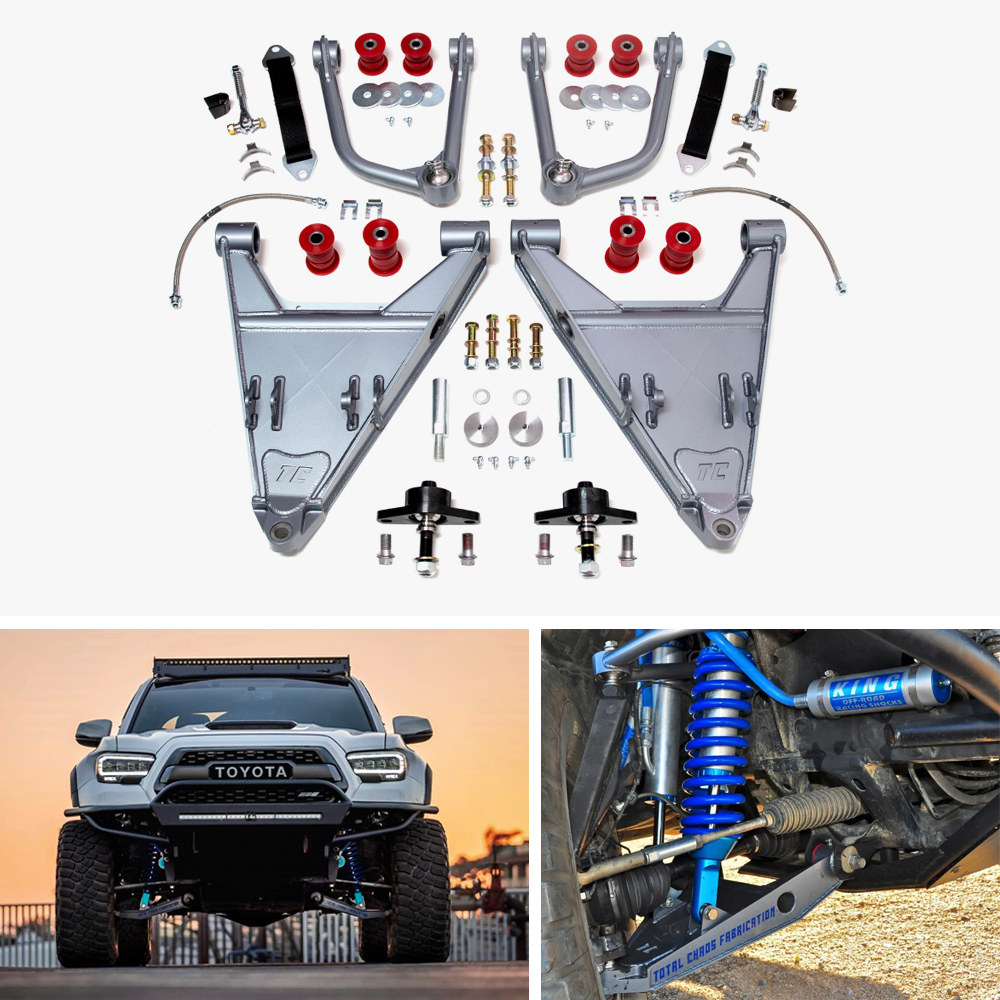
Total Chaos has long been the leader of the LT segment for decades when it comes to LT Toyota applications. They offer everything from beginner kits to extremely advanced kits and for many makes and models. They are well known for their wide variety of sizes. They offer parts for both the front and rear of your Tacoma and if they don’t have a full plug-and-play option for the rear – they work with just about every company out there so they can recommend a comparable rear setup for whatever front you decide to purchase.
Kit Offerings
Total Chaos leads the race offering 4 total kits; multiple +2″ and +3.5″ kits. The +2″ expedition kit offers 2″ more ground clearance than the +2″ standard series kit. In the +3.5″ class, they offer two kits; the standard series & race series. The race series +3.5″ kit provides 2.5″ more ground clearance and is 5 pounds lighter per lower arm than the standard series +3.5″ kit. You can get any of these kits with bushing or heim pivots at the UCAs.
- +2″ Standard Series
- +2″ Expedition Series
- +3.5″ Standard Series
- +3.5″ Race Series
Find it online:
2005-2015
2016-Current
Trail Takeaway
Total Chaos starts at around $3100 and goes up from there. If you’re looking at the 2″ class, you might as well opt for their +2″ Expedition Series at $3600 as it gives you another 2″ of ground clearance over their standard kit. The same applies to their +3.5 Race Series kit. It’s only another $500 for less weight and more ground clearance.
The downside of Total Chaos is that they use poly bushings and not sealed uniballs or even open uniballs for the pivots. Also, the TC lowers are boxed and do not feature a slant for sliding over obstacles which you should consider if you like the rocks. Finally, you can buy the axle shafts on Total Chaos but you will need to assemble your inner and outer joints. They do not offer fully built axles at this time.
2. Camburg (+2″ and +3.5″)
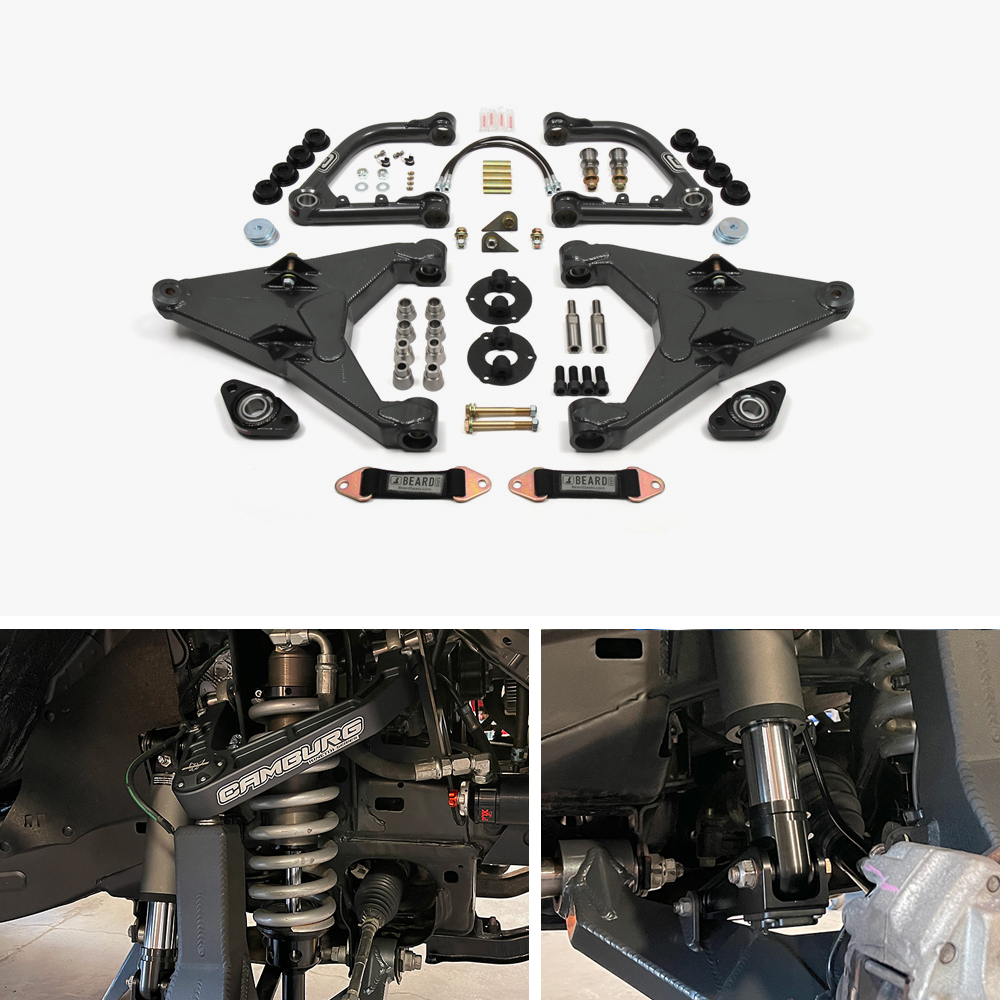
Camburg is a race truck company at the core and they have been for over two decades. They build chassis, and axle housings for trophy trucks from the ground up and provide some of the most dependable parts for quite a few Ultra4 class builds. Camburg isn’t just moving the needle when it comes to quality fabrication, they also bring insane ingenuity to the table. They just released their new “slapper arm” kit which is a hydraulic bump stop connected to a lower control arm via a link. Simply put, it’s designed to vastly improve bottom-out control. If you like FOX shocks, you’re right at home with Camburg. They pair just about everything they build with FOX, however, Kings work as well.
Kit Offerings
Camburg currently offers two kits; a trail series +2″ kit with the slapper arm bump stops and a race series 3.5″ kit which can also be optioned with the slapper arm bumps. Both are available with bushing or heim pivots at the UCAs. You can add extended-length axle shafts, however, they do not come assembled. You will need to reassemble your outer and inner joints once the shafts come. For spindles, Camburg doesn’t offer a spindle gusset kit, however, they offer their fabricated performance spindle kit which works with their LT kit. If you want to option secondary bypass shocks, you need to call or order them separately. Also, if you want double-shear steering and outer/inner rod ends – you need to call.
Find it Online:
Trail Takeaway
Camburg sells a bunch of parts for the rear as well; HD Deaver springs, a pre-fabricated bed cage, leaf perches, and a spring under kit. This company is the real deal when it comes to LT as they have been in the game for decades. The only challenge I see with the Camburg lower arms is that they sit lower than other arms due to their lower ball joint adapter kit on the LCAs. If rock crawling is important, this might be a kit you want to avoid as you will lose clearance here.
3. Dirt King (+3.5″)
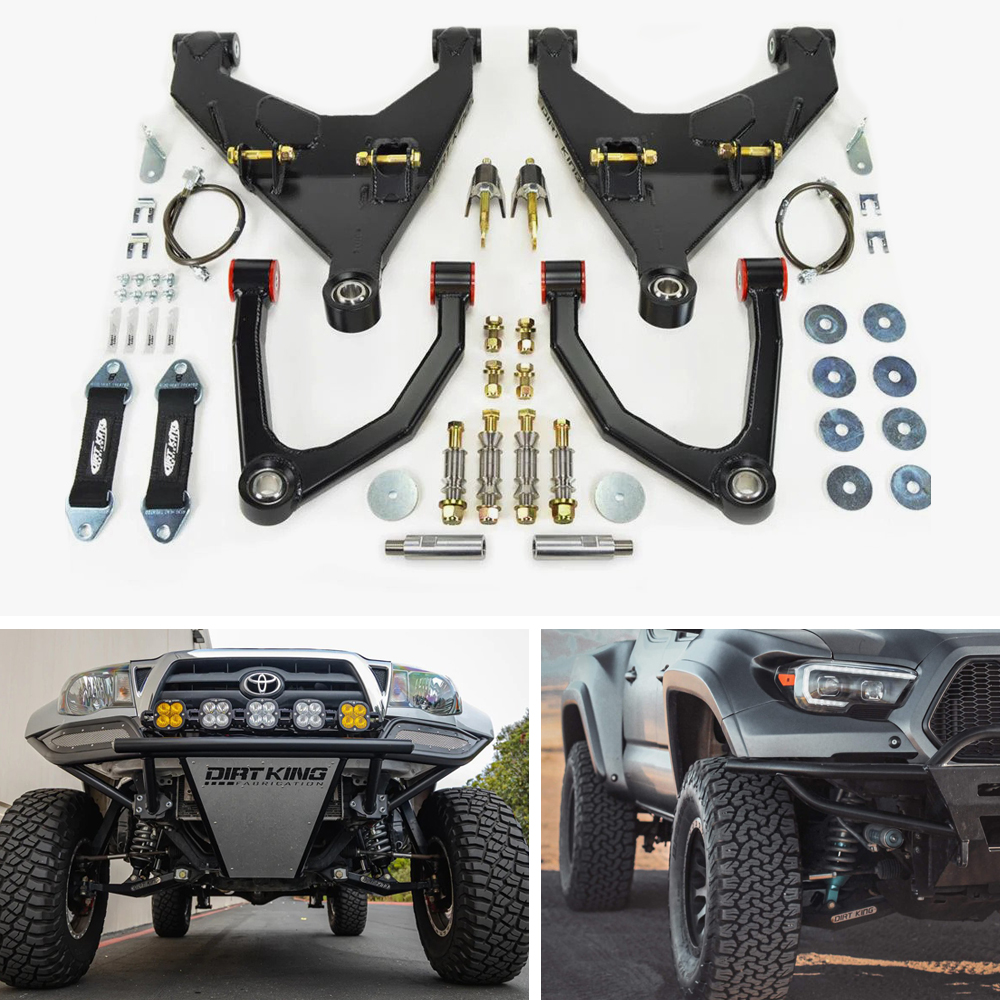
Dirk King is relatively new to the long travel scene with roots back to 2011. DK got its start with Prerunner style front bumpers and custom fabrication services – with a focus on the Titan market. Then they finally entered the Toyota market with their boxed upper control arms in 2014, and then finally LT kits sometime around 2015-2016. Although Dirk King is relatively new to the scene, they have quickly become an industry leader. Right up there with Camburg and Total Chaos, Dirt King is quickly gaining market share with their high-quality kits and full-service product offering. I really like what Dirt King has to offer for LT.
Kit Offerings
They offer the +3.5″ race kit at this time boasting an impressive 13.5″ of wheel travel with the option of bushing or heim pivots at the UCAs. Their lower control arm features an aggressive slant on the forward face instead of a boxed design which will help clear obstacles in the rocks. Another notable selling point is that they use Derlin bushings, not poly bushings like TC. Finally, the DK lowers feature built-in forward positioning of about 1/2″ which pushes your wheel forward which is a plus for wheel placement for larger tires.
Find it Online:
Trail Takeaway
DK offers many secondary components that complement the kit both front and rear. To start, they sell fully assembled axles with the inner and outer CV joints assembled on LT shafts – shipped to your door. Not many companies other than JD Fabrication offer fully-built LT CV axles. This is a huge upsell for some who don’t want to pull apart inner and outer CV joints.
Dirt King also offers a spring under kit for the rear, a prefabricated bed cage designed for 16″ shocks, and the H70 HD Deaver springs you need for the rear. They also sell all the compatible coilovers, triple bypasses, and rear shocks for an LT kit. Dirt King carries and sells literally every part you need for a full plug-and-play LT kit for the 2nd and 3rd Gen Tacoma.
4. JD Fabrication (+2.25″ and +4″)
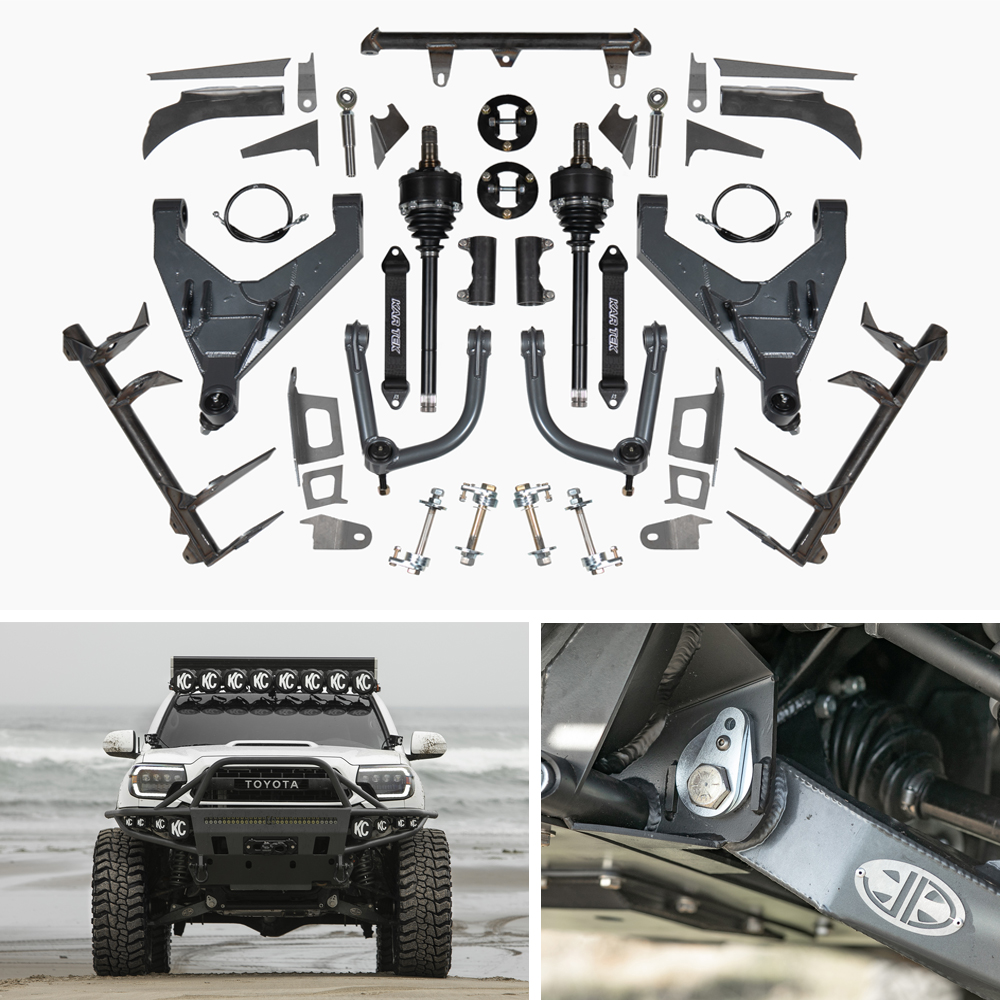
JD Fabrication builds desert race trucks and fabricates some pretty interesting parts that no other company makes. Their team has built long travel suspensions for well over 20+ years. These guys offer every solution the industry wants for LT, but be prepared to pay. Let’s start with their LCA pivot kit. This is the answer for larger tires. This kit removes the factory LCA mounting points and welds in a wider replacement with adjustable cams which push the lower control arm up to 1″ forward. That’s not pushing the caster (measured in degrees) forward, that’s pushing the center point of where your wheel mounts to the LCA.
This will clear a 33″ tire without any modification at all, a 35″ tire with minimal modification, and a 37″ with mild modifications (pictured above). JD Fabrication also offers one of the strongest CV axle joints on the market; the 934 Chromoly caged plunging CV joint with 300m axle shafts.
Additionally, they offer a set of inner fender replacements, a steering rack “slide rack” reinforcement, and all the other bells and whistles that most mainstream companies are producing; LT bypass shock hoops, double shear steering upgrade, Chromoly tie rods, spindle gussets, steering pump upgrades, spring under kits, and more.
Kit Offerings
They offer +2.25″ and +4″ length kits with just about everything you need to go along with them. We wrote a full overview blog post on their 2.25″ long travel kit and then another step-by-step installation guide as well. If you want to read more about the JD Fabrication offering, check out those posts for more on their kit offerings.
Find it online:
2nd Gen Tacoma (2005-2015)
- 2005-2015 Lower Arm Pivots $100 Off (Coupon code “trailtaco”)
- 2.25″ Long Travel Kit
- Front Skid Plate
- 934 CV Axle Upgrade Kit
3rd Gen Tacoma (2016-Current)
- 2016-Current Lower Arm Pivots $100 Off (Coupon code “trailtaco”)
- 2.25″ Long Travel Kit
- Front Skid Plate
- 934 CV Axle Upgrade Kit
Trail Takeaway
You can buy everything you need from JD Fabrication. One really important detail about JD Fabrication is that they do not use heims on their UCAs as heims that are exposed to the elements don’t hold up through extreme weather conditions. Instead, they have machined upper and lower uniball inner pivots that accept seals and are 100% weatherproof. At the time of writing, no one else offers sealed uniballs where the uppers and lowers pivot. Additionally, they use very high-quality sealed EMF uniballs for the outer pivots. This is a dependable LT kit for those that live in an area where harsh weather is consistent, or you drive on the beach with salt water, among many other scenarios.
All of their kits are constructed out of 1/8″ and 3/16” Chromoly with extensive internal ribbing. They also incorporate an integrated CV “pocket” built into the LCA so the arms can achieve more ground clearance. Finally, JD Fab kits will work with the OE style king and Fox shocks.
This is the kit we choose to run on our 2G Tacoma for a reason. It stands out from all the other companies on the market for our intended use; heavy rock crawling with trips to the beach and go-fast moments here and there. This kit really does it all – which is why I wrote this post.
5. LSK (+4.5″)

LSK makes a couple of monster long travel kits; a race kit for 2wd Tacomas pushing almost 16″ of travel, a spindle bolt-on kit for 2wd trucks pushing 14″ of travel, and a kit for 4wd rigs also pushing 14″ of wheel travel. All kits are +4.5″ wider on each side and come with the LSK signature heim pivot UCAs. And, instead of uniballs or ball joints connecting at the spindle, they feature heims boasting a full range of articulation where your only limit is how you set your limit straps and build your fender wells.
LSK is very different from every other kit on the market due to its unique a-arms, heim pivots, cam lockout plates, and supplied pre-built spindles. They also provide everything else you need for your kit; rod ends that connect double shear at their spindles, DOT extended brake lines, secondary shock hoops, the necessary shocks, and all the hardware you need to link it all together.
Kit Offerings
Even though they call their kits “bolt-on” there are still some areas that need to be welded so don’t let the product titles fool you. All in all though, if you’re going with a +4.5″ LT kit, you’re not worried about a little welding.
LSK does provide extended-length RCV axle shafts, however, you’re responsible for rebuilding the outer and inner joints when the shaft arrives. If you want prebuilt axles, just order +4.5″ LT axles direct from RCV – booted and all.
Trail Takeaway
This is the kit you buy if you want to go extremely fast, maybe swap in a 2JZ, LS, or something insane that warrants some serious race travel.
6. Marlin Crawler RCLT (+2.75″ and +3.5″)
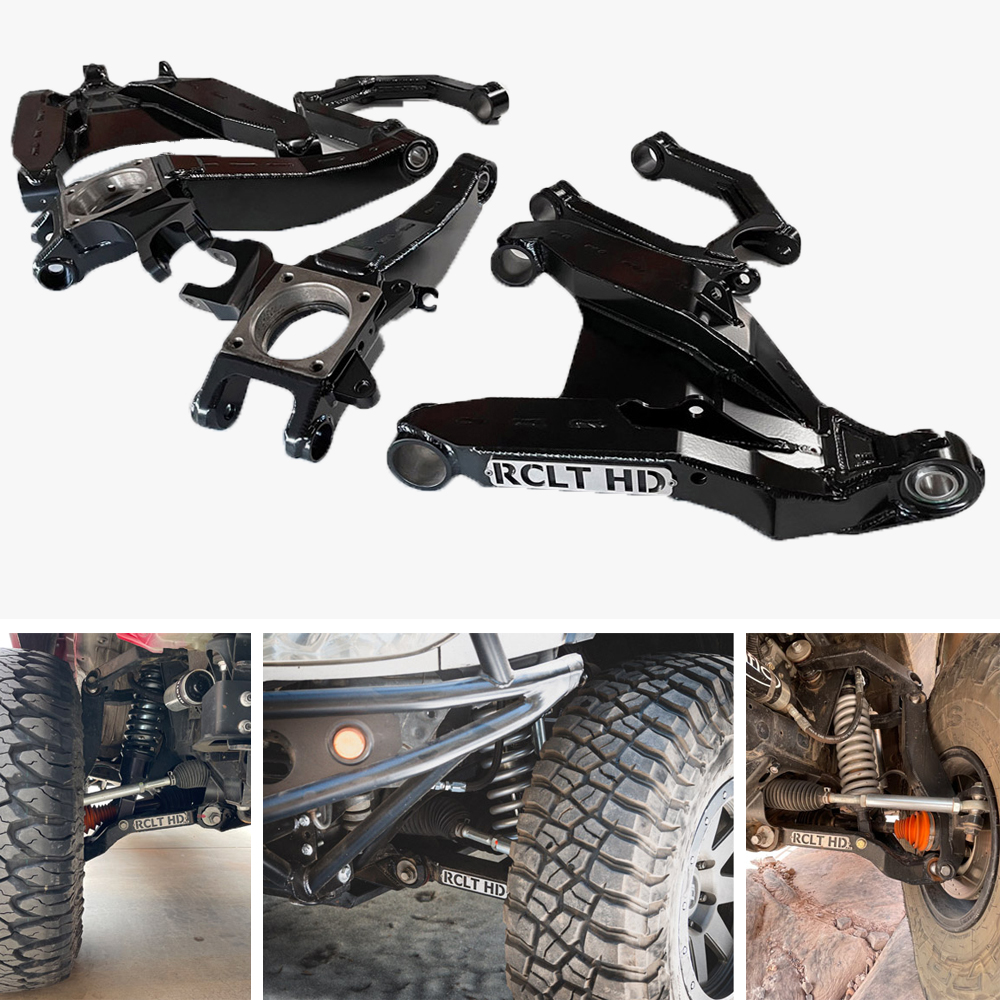
The leader in everything offroad is Marlin Crawler. They have led the race in aftermarket part fabrication for decades and their RCLT kit is no exception. It’s by far one of the most advanced long travel systems specifically designed for rock crawling, hence the name “Rock Crawling Long Travel”.
This is Marlin Crawler’s first venture into the IFS world and offers two options for the new LT kit; the +2.75″ and the +3.5″ version both pushing 12.5″ of wheel travel measured at the hub and 14.5″ at the centerline. The kit comes with horizontal ball joint linked at the spindle and bushing pivot UCAs, CAD design pre-fabricated knuckles/spindles with double shear steering points for their MarRack (200 Series Land Cruiser Rack), 1/4″ mild steel boxed lower control arms with horizontal ball joints, and finally, the kit uses FK uniball bearings and tie rod ends. The kit’s knuckles are pushed forward +2″ over the factory increasing both forward wheel positioning and approach angle.
Kit Offerings
Marlin Crawler has a few configurable options for this kit but it really breaks down into their “Standard Installation” which runs you about $9000 and their “Ultimate Installation” which sets you back almost $12,000. That’s with everything you need out the door; LT kit, shocks, axles, and steering rack.
The LT kit alone is around $7500.00. Then you have to pay for your shocks (coilovers and optional bypasses), the 200 Series Land Cruiser steering rack, and CV axles. This is a great LT option if you’re solely looking to dominate the rocks.
Trail Takeaway
This kit is designed for the person that really wants this kit. Marlin Crawler has done a great job of selling this kit as the “premier option” and “leader” in rock crawling IFS, however, there are other kits that compete. Just because the slowest Tacoma on IG (owner of Marlin Crawler) is running 40s with this kit doesn’t mean you should or can. That Tacoma is also running dual cases (Marlin Crawler Taco Box) which helps to reduce the stress on many other parts and maintain control when wheeling at low and high torque. Running a reduction box is very important if you’re considering IFS on 40s for many reasons. These RCLT parts are impressive, yes. However, they do oversell some points on tire size and don’t tell the whole story of what really needs to be done to run 40s.
7. Baja Kits (+2″)
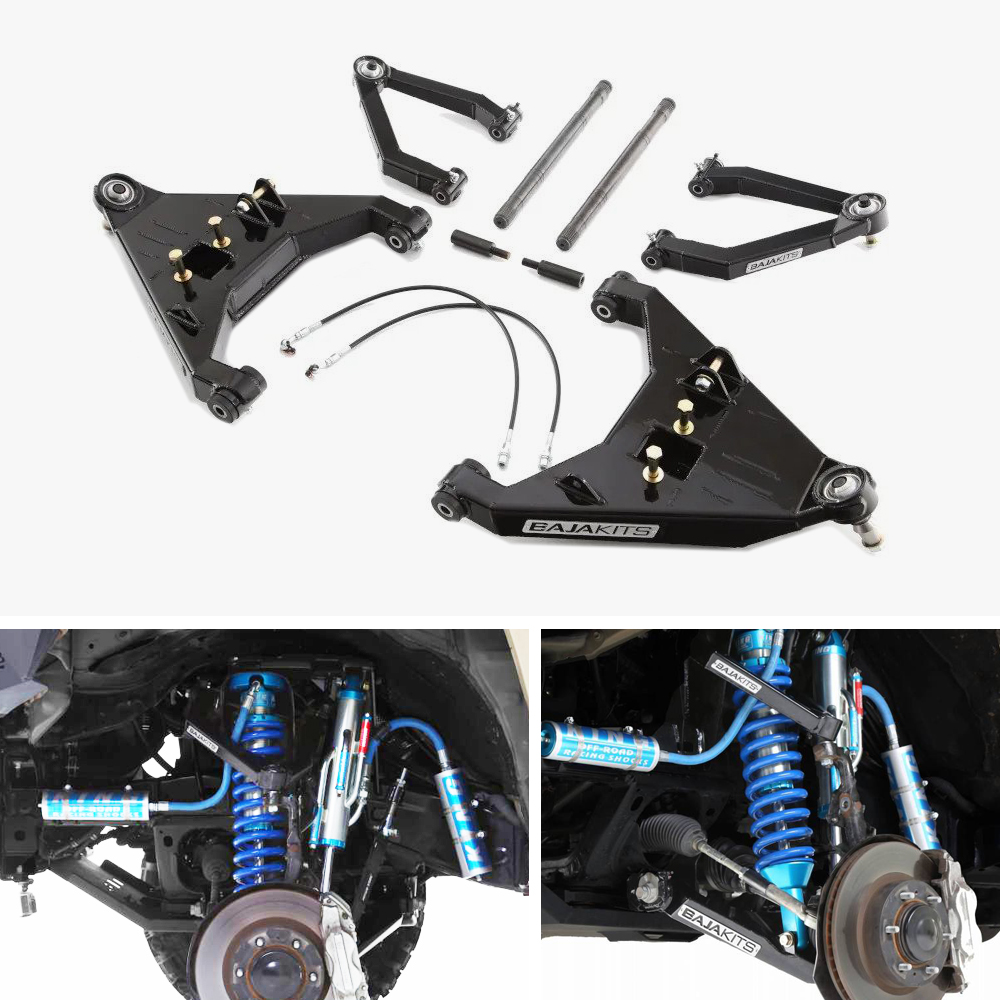
Baja Kits offers a +2″ kit pushing 11″ of travel. This kit is about as straightforward as it gets when it comes to long travel; boxed upper and lower A-arms, Delrin bushings pivot the UCAs/LCAs, uniballs, extended brake lines, and all the hardware you need to install. Baja Kits does show a photo of their “heat-treated axle shafts” that comes with the kit, however, they do not quote whether or not it’s Chromoly or 300M. We also don’t know if they use mild steel or Chromoly for the construction of the arms. At this time, no options are configurable for assembled axles, limit straps, cans/brackets for hydro bumps, spindle gussets, and/or UCA double shear gussets (although they do sell these separately), hoops for bypasses, and nothing in the steering department either. They do, however, sell King coilovers and bypasses.
The kit does not come with options for what most would consider “must-haves” when building a long-travel suspension so if you want a fully built-out LT kit with all the bells and whistles, you might want to look elsewhere.
All in all, you know the quality is there with Baja Kits because of their parent company. Brenthel Industries (a race truck build, design, and engineering company), builds and manufactures all their uppers and lowers.
8. All-Pro Off-Road (+2″)

The All-Pro Offroad kit is a +2″ kit boasting 12″ of wheel travel and 2″ of ground clearance. All-Pro Offroad actually offers a pretty robust kit for the money. For a similar price to what most kits sell just uppers and lowers for, All-Pro Offroad includes the majority of parts you need. In this +2″ long travel kit you will find tubular-style Chromoly UCAs and LCAs, limit straps with brackets, DOT brake lines, spindle gussets, rod end extensions, along with the inner and outer CV boot kit. The only items you won’t find included in the kit are shocks, bump stops and axle shafts. And, if you want secondary shocks, you will need to source the hoops and bypasses separately.
For around $3200, it’s actually a pretty good deal for a +2 kit. The uppers and lower are not boxed, but they are Chromoly so you know they’re plenty strong. The fact that it’s being manufactured and sold by All-Pro Off-Road should give you plenty of peace of mind going into the purchase.
These kits has been around for quite a while now. If you’ve been watching All-Pro recently, they’ve been slowly giving sneak peaks of their completely redesigned system. A system that is supposed to be a superior, direct competitor for the RCLT HD kit. More to come soon!
Find It Online
Final Thoughts
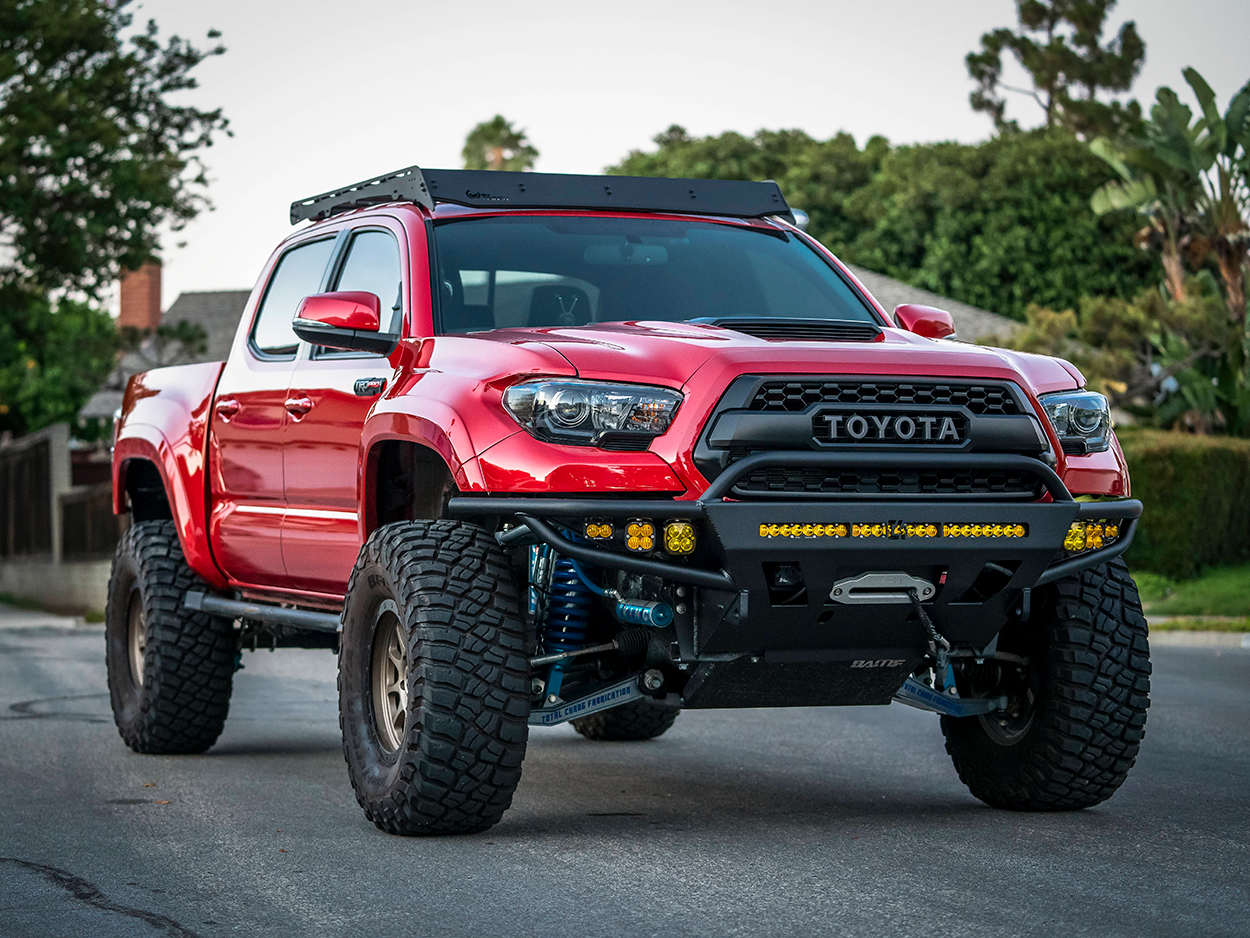
There is an LT option out there for everyone, however, the two most robust offerings on the market are from JD Fabrication and Marlin Crawler. Both companies offer the complete package and a quality solution for Toyota IFS.
JD Fabrication
We decided on the JD Fabrication 2.25″ kit for our Gen 2.5 Tacoma previously pictured above. JD Fab offers selling points that no other company offers, mainly found in their LCA pivot kit. The LCA pivots allow for larger tires without extensive cutting and/or tubbing of the firewall, depending on tire size. If you want to maximize tire clearance around the firewall, keep your Tacoma aligned to factory spec with the arms in the center of the adjustment range, and eliminate side load on pivot bushings all without sacrificing on-road driver comfort, then this is a kit to consider. They also paid very specific attention to ensuring that every pivot point on the suspension is fully sealed making the kit ideal for those that live in harsh climates.
This kit offers the best combination of “go fast” strength while still maintaining insane ground clearance in the rocks thanks to the integrated CV pocket. JD Fabrication has been building long travel suspensions for over two decades and on paper, their new LCA pivot kit challenges almost everything we know about Toyota IFS. The cool part about the LCA pivot kit is the pivot opening is the same as the factory which means you can run any lower arms that fit the factory all while pushing the tires forward upwards of 1″. Your options are endless with JD Fab, you can piece your own LT kit together or you can stay within the JD Fab ecosystem of products and also end up with a very custom setup.
Marlin Crawler
The Marlin Crawler 2.75″ RCLT sits at the top as another IFS LT contender and some will argue that it’s the best rock-focused LT kit out there, however, some have debated that point and the quoted travel numbers. That said, it’s made by Marlin Crawler who’s been a staple brand in the off-road community for decades so you know you can trust their quality which is why I think it’s a great option. The kit does feature quality selling points like a fully fabricated spindle and horizontal uniball pivots. These are nice, but a fully fabricated spindle doesn’t guarantee more up-and-down travel based on articulation range alone. Wheel travel is also limited by the inner fender well, fenders, bump stops/mounts, among other limiting factors.
RCLT quotes the kit as compatible with a 40″ tire as that is the tire size warranty limit of RCV axles, and the arms do push the tires forward upwards of 2″, however, a lot of work goes into running 40″ tires on Toyota IFS. You can expect more work than just upgrading your steering rack, CV axles, and connecting double shear points on the spindles. Also, keep in mind that the MarRack is simply a Land Cruiser 200 series rack. We installed one on our 2nd Gen Tacoma almost a year ago so it can be done on your own with any other kit, given you have the know-how. The benefit of buying a kit from Marlin Crawler is that you get their install kit for the rack which includes a jig and all the secondary hardware needed to connect the shaft. On the landing page of bullet points and benefits, Marlin Crawler sells the kit well, however, you need to source many extra parts on top of their kit. At the end of the day, you don’t have that many options with this kit. They offer two options and they’re both very expensive.
Other Options
LSK, like Marlin, also offers a very comprehensive kit with their fabricated spindle, although there is very little information online about their testing and performance.
If you’re looking for a bolt-on kit, Camburg, Dirt King, All-Pro Off-Road, and Total Chaos offer great entry-level to advanced options. These companies all offer straight bolt-on options along with add-ons that require fabrication as well. You can expect fabrication work anytime you add additional parts like secondary shocks, hydro bumps, and limit straps, among other items.
Within each of the company offerings, most differences come down to LCA and UCA design. Reference that section on this post again, and you’ll understand how important every aspect of the LCA and UCA design is when purchasing a kit.
It’s hard to choose one kit on this page as the “best” as there is no best in this industry, only the best for how you intend on using your truck.


People incorrectly assume that tire width affects traction and it is actually the longitudinal section where the tire is in contact with the ground. The way to increase this contact area is with a taller tire and not a wider tire. Wide tires are good for floating over snow and sand but those are special case situations. Wide tires that extend past the sides of the truck are a good way to toss rocks up against your truck and any vehicle or person in your vicinity.
Great article… I’ve got a TC Race 2” on my 5th gen 4runner. I love the functionality but after fighting the poly bushings for years I’m ready to find a new system if I can’t find a lasting solution to their noise. They’re way too noisy! Any suggestions on managing the noise of poly bushings? (Other than lube and maintenance) If not, I’m ready to move on. Thanks!
Very very informative article, I currently have a stage 1 mid travel kit on my 3rd gen mostly used for overlanding and camping, but have been looking to upgrade to a “go-fast” LT set up and couldn’t have found a better article. Thank you lots I will rely heavily on your info as I still consider myself new to the OR community.
Great read !!
Awesome, glad you enjoyed it. Only took me 2-3 months to write. haha
Only question I have is how much of my current set up can I salvage or does it all have to b changed for a LT coming from the Mid Travel
It depends on the setup you’re running but for most kits you replace everything. You can always keep your factory spindles, steering rack along with inner and outer CV joints, but everything else is longer and wider. Those parts include coilovers, tie-rods, CV shafts, LCAs, UCAs, in addition to all the other parts and pieces you need. Things like limit straps, optional cam tab gussets, and optional double shear components if you choose to go that route.
i thought so, well seems my 2.5 kings are going on my dads 2nd gen lol
thanks for the response and info
Going down the road of long travel for my 3rd gen Tacoma right now and this is by far the most helpful information online. Thanks for this.
Awesome, let me know if you have any questions.
correct me if I’m wrong, but if this adds some width to the front then what do you do to the back, like would you have to use spacers or offset wheels only in the back?
Yeah, you’re right. On our JD FAB 2.25” LT we’re running 1.25” spacers in the rear to match the front.
no mention of the Solo Motorsports XLT kit which is +4.5″ and offers 19″ of useable travel with 4wd
Yeah Solo makes some killer stuff. I’ll work on getting them integrated into this post when I have some free time. Thanks for the heads up.
Great writeup! I can’t wait to get my Total Chaos kit on my truck!
This is probably one of the most informative articles that truly adds value to the conversation of LT for Toyota.
Talk about a walk through of all of the pros and cons! LT is a very in depth subject for any vehicle, it’s nice to see a thorough dissection of the products available and why one might be better for someone over another. Bravo! I would like to see a little more general information on the maintenance that can be expected with an LT equipped truck, because there is a lot more than a stock setup 🙂
DUDE. Wow. I’ve spent a lot of time over the years doing quite a bit of research to really understand how to build my truck. Resources that go this deep are few and far between. This is definitely one you need to bookmark. This an essential post on all things long travel. I learned quite a bit too! Also, having driven your 2G, the JD Fabrication really is next level. That pivot kit is a game changer.
This was super informative, I didn’t realize that true LT started at 2″ always thought it was 3-4″+). TONS of considerations it seems if you want to do LT the right way and this is an excellent resource to get started ??